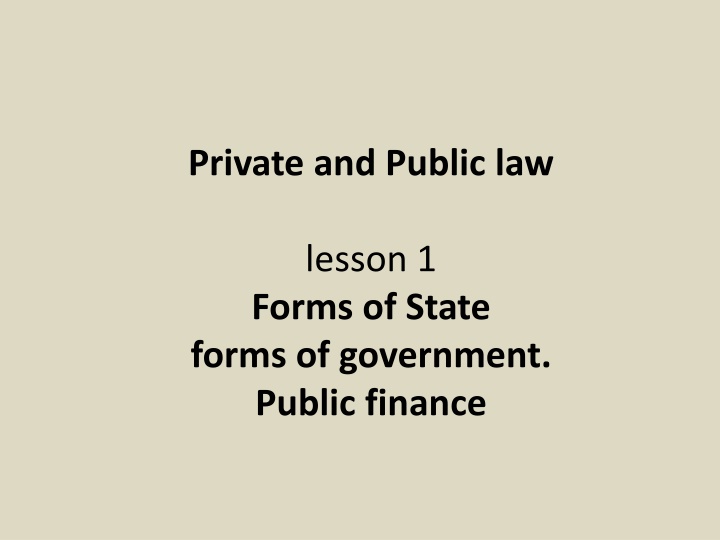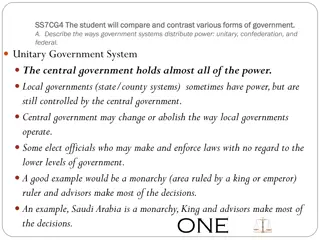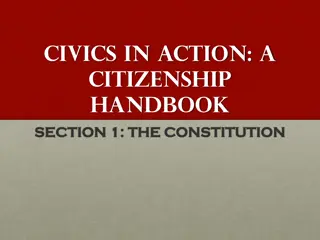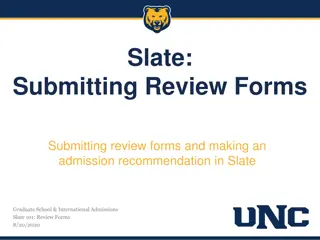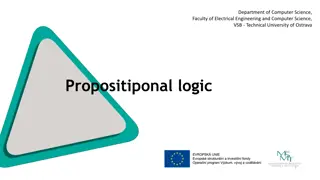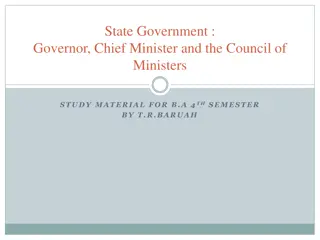Forms of State and Government Overview
This content provides an insightful look into different forms of state and government, including the main features of a state, various forms of state like feudal society, socialist state, and welfare state, centralised versus decentralised state structures, and examples such as the Italian Constitution, unions of states like the European Union, and intergovernmental organizations. Additionally, the content delves into the UNO Charter and its provisions. Explore the nuances of state structures, forms of government, and international organizations through this informative content.
Download Presentation

Please find below an Image/Link to download the presentation.
The content on the website is provided AS IS for your information and personal use only. It may not be sold, licensed, or shared on other websites without obtaining consent from the author.If you encounter any issues during the download, it is possible that the publisher has removed the file from their server.
You are allowed to download the files provided on this website for personal or commercial use, subject to the condition that they are used lawfully. All files are the property of their respective owners.
The content on the website is provided AS IS for your information and personal use only. It may not be sold, licensed, or shared on other websites without obtaining consent from the author.
E N D
Presentation Transcript
Private and Public law lesson 1 Forms of State forms of government. Public finance
The main features of State ______________________________ - independence - preeminence - based on a territory - general aims
The forms of State _________________________________ - The feudal society - Absolutism - The police State - The modern State (rule of law) - The socialist State - Authoritarianism The welfare State
Centralised State Decentralised State regional State(s)
Institutional decentralisation Bureaucratic decentralisation Self-government
Decentralisation in the Italian Constitution _________________________________ - Article 5 of the Italian Constitution ( The Republic is a single and indivisible entity ) - Article 117 (State s powers; common powers; Regions powers) - Article 119 (Financial powers and duties of the Regions)
The Unions of States Confederations In particular: the European Union
intergovernmental organizations supranational organizations
Example: the UNO Charter _________________________________ Art. 41 - The Security Council may decide what measures not involving the use of armed force are to be employed to give effect to its decisions, and it may call upon the Members of the United Nations to apply such measures. These may include complete or partial interruption of economic relations and of rail, sea, air, postal, telegraphic, radio, and other means of communication, and the severance of diplomatic relations Art. 42 - Should the Security Council consider that measures provided for in Article 41 would be inadequate or have proved to be inadequate, it may take such action by air, sea, or land forces as may be necessary to maintain or restore international peace and security. Such action may include demonstrations, blockade, and other operations by air, sea, or land forces of Members of the United Nations
The constitutional elements of States ______________________________ - Territory - People - Sovereignty
Territory ______________________________ - natural and artificial borders - Article 241 of the Italian Criminal Code: crimes against the State territorial integrity - Does a State legally survive an invasion? - extra-territoriality (e.g., international sanctions against Iran)
Territory ______________________________ - territorial immunities - What about colonies? - Is the State s rights over its territory ad rem rights, similar to those regulated by the Italian Civil Code? - territorial and non territorial entities (art. 114 of the Constitution) - the State s non transferrable assets
People ______________________________ - The status of citizen: rights and duties (<> residence; domicile) - Values and interests in common? ( idem sentire de re publica ) - people = nation? - Art. 11 and 22 of the Italian Constitution: gain and loss of citizenship; waiver - Non-citizens and stateless people (apolidi)
What is nation? ______________________________ - multi-national States - Articles 6, 3, 51, 9, 11, 16, 49, 67, 87, 98, 117 and 126 of the Italian Constitution: The members of the Parliament represent the nation The President of the Republic represents the unity of the nation public employees shall exclusively serve the nation
Sovereignty ______________________________ - Art. 7 of the Italian Constitution: the State and the Holy See - power to issue laws, administrative decisions; theories about sovereignty - Art. 1 of the Italian Constitution: people as the holder of sovereignty - the State is (also) sovereign?
Limitations to sovereignty ______________________________ - Article 11 of the Italian Constitution (limitations to sovereignty) - Regulations (or Directives) issued by the European Union - Articles 41 and 42 of the UNO Charter
Forms of State/government and public finance
public finance - Establishing duties and taxes - Managing assets owned by the State and other public bodies - Making available resources (through public services, investments and works)
Main principles of public finance: - Political aims and general purposes - Control by the parliamentary assembly
Historically: - the functions afforded to the State have been eroded by both the EU and by the increasing powers of territorial entities - within the State, the role played by the Government has become increasingly important; the importance of the parliamentary assemblies has declined
Role of the Parliament: Approval of the State financial statements: political priorities are established Approval of rendiconto : subsequent control over the Government s actions, which should be in compliance with the approved financial statements Missing approval resignation of the Government members? (art. 94, para 4)
No taxation without representation - United Kingdom - XIX century Germany - Liberal State (majority approach) - Social-democratic State
Provisions of the Italian Constitution on public finance - art. 23: all fundamental decisions regarding financial policy (establishing new taxes) must be adopted by the Parliament. However, due to high sophistication, the intervention of the Government is often significant - art. 53: main criteria to which public finance policy must conform: (i) tax treatment must be proportionate to the capacity to generate revenue: (ii) as long as such capacity is increased, tax obligations should get tighter
Fiscal compact (Treaty on Stability, Coordination and Governance in the Economic and Monetary Union, signed on 2 March 2012 by all EU Member States, except the Czech Republic, the United Kingdom, and Croatia) Member states bound by the fiscal provisions of the treaty will face annual fines up to 0.1% of GDP, if they after one year of the Fiscal Compact entering into force for them, have failed to enact a domestic "implementation law" establishing a self-correcting mechanism, guided by surveillance of a governmentally independent fiscal advisory council, which shall guarantee their national budget be in balance or surplus under the treaty's definition. The treaty defines a balanced budget as a general budget deficit not exceeding 3.0% of the GDP, and a structural deficit not exceeding a country-specific Medium-Term budgetary Objective (MTO) which at most can be set to 0.5% of GDP for states with a debt-to-GDP ratio exceeding 60% - or at most 1.0% of GDP for states with debt levels within the 60%-limit.
Fiscal Compact implementation mechanics - Italy - France - Germany
Art. 81: the State must ensure appropriate balance between available resources and expenses. To that purpose, it must also take into consideration any favorable/unfavorable economic cycles Art. 119: an analogous principle is set out with respect to territorial entities Art. 97: all branches of the public Administration must ensure steadiness of the accounts and sustainability of their debt
New article 81, paragraph 3 of the Italian Constitution: obligation to provide coverage for all laws contemplating new expenditures - Consider any possible unbalances: (i) additional, unexpected expenses; and (ii) lower incoming amounts - Ratio of the norm: (i) decision on expenditure coverage must be contextual with the decision on the relevant expense; (ii) both decisions are made by the same subject (responsibility)
The law approving the financial statements is no longer a formal act of the Parliament, since it may now include decisions regarding new taxes or new expenses
May the law approving the financial statements allow the State to resort to incur new indebtedness? - Past approach: the scholars and the Constitutional Court tended to endorse such approach (see decision no. 1/66) - Now: EU constraints: thresholds of 3% of deficit to GDP and 60% of debt to GDP + new article 81, paragraph 2: faculty to incur new indebtedness only in case that exceptional circumstances occurred ( serious economic recession / extraordinary events the State may not control ) + approval by the absolute majority of both Chambers
SPECIAL FUNDS - Past approach - Now: expense funds may not be utilized unless the relevant active funds have been created (or re-created)
The role of the main bodies involved in the approval of the financial statements - The President of the Republic . He is entitled to reject final approval of laws/decrees, highlighting the need for a more thorough analysis by the Parliament . He is entitled to identify any potential breach of the Constitution (not only with respect to coverage) . Moral suasion - Corte dei Conti . The expenditure coverage policy is scrutinized . A report is submitted to the Government and to Parliamentary Commissions on a four-month basis . A report is attached to the rendiconto generale . It may defer any question to the Constitutional Court (e.g., to detect any breach of the new art. 81, para 3 of the Constitution) - The Constitutional Court
